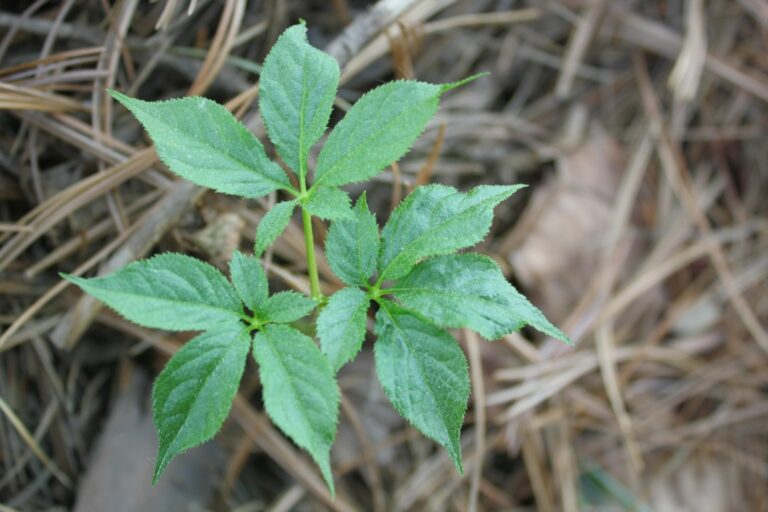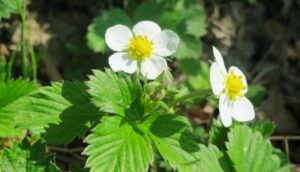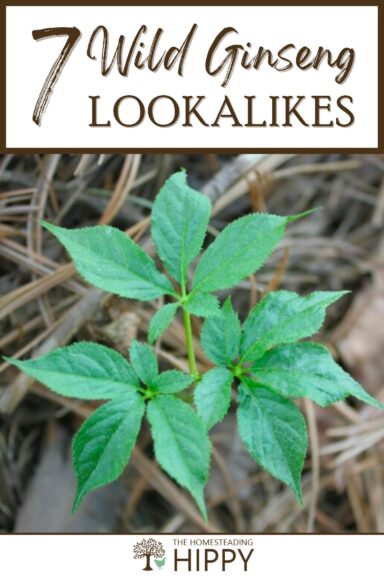Wild ginseng has to be one of the most coveted plants all around the world. Loved in Asia and throughout America as an energy booster, wild ginseng is ceaselessly tracked down by armies of enthusiastic amateurs and seasoned, expert foragers called ginsengers.

And finding this precious root is anything but easy: ginseng grows and develops slowly, is commonly eaten by all sorts of wild animals and has very specific environmental requirements to grow at all.
And, worst of all, it has many lookalike plants that can frustrate even a seasoned ginseng hunter.
The good news is that most of these lookalikes are helpful themselves or harmless, but some aren’t. I’ll tell you about seven of the most common ginseng lookalikes below…
Table of Contents
1. Black Cohosh (Actaea racemosa)
You might mistake the Black Cohosh (Actaea racemosa) for ginseng, given their similar woodland habitats and the somewhat similar arrangement of their leaves.
Black Cohosh has deep green, finely divided foliage, which can easily be confused with the palmate leaves of ginseng.
However, Black Cohosh stands out with its tall white “candles” of flowers that bloom spectacularly in the shade during midsummer.
This plant is a native of Eastern North America, and draws the ire of ginsengers from Maine to Georgia.
Note that Actaea racemosa is also known by several other common names like black bugbane, black snakeroot, rattle-top, or fairy candle.
Its, ah, unique (read: nasty) odor also attracts flies, gnats and beetles, making it an integral part of the ecosystem.
But definitely don’t be fooled by its beauty or by its similar appearance to ginseng. While not typically deadly, Black Cohosh is definitely not safe to ingest due to certain conditions associated with it.
2. Wild Sarsaparilla (Aralia nudicaulis)
Wild Sarsaparilla, or Aralia nudicaulis, is another plant that could easily be mistaken for ginseng.
Sarsaparilla sports a single leaf stalk that divides into five leaflets, somewhat resembling the overall leaf structure of ginseng.
The similarity is quite misleading, especially to beginning botanists, but close observation reveals that Sarsaparilla’s leaves are thinner and more oblong compared to the broader leaves of the ginseng plant.
Found all across the cooler regions of the United States and Canada, Wild Sarsaparilla has long been known for its clinary applications and is considered safe to eat in a variety of contexts.
What’s even more interesting is that Wild Sarsaparilla was once a popular ingredient in soft drinks throughout the late 19th century, used in place of true Sarsaparilla extract.
The plant that you might easily confuse with ginseng might have been a part of your great-grandparent’s favorite childhood drink!
3. Poison Ivy (Toxicodendron radicans)
You already know to beware of poison ivy; you don’t need me to tell you that! But worse yet, this hated plant might trick you into thinking it’s ginseng: that’s because of its three leaflets.
The leaves of poison ivy are usually glossy and green, but they can turn red or orange in the fall, a dead giveaway considering ginseng leaves turn a pale, ghostly yellow.
This plant is native to North America and Asia and can be found in a variety of habitats from forests to fields, and everywhere in-between, even in urban areas.
Note that poison ivy can grow as a vine or shrub, and well-known for its ability to climb high up into trees, so watch where you put your hands.
And of course, unlike the beneficial ginseng poison ivy is harmful: It contains urushiol, a light, colorless oil that will cause an itchy, blistering rash upon contact with upwards of 95% of the population; a lucky few are immune.
Despite its toxic nature to humans, poison ivy berries are a favorite food of many birds and other animals during the winter months, so think twice before eradicating it.
4. Buckeye (Aesculus glabra)
The Buckeye, or Aesculus glabra is a tree that might confuse you for ginseng when young due to its palmate leaves which bear more than a passing resemblance and its tendency to grow in similar regions.
The Buckeye tree has compound leaves with five to seven leaflets arranged in a fan-like pattern, similar to ginseng, and it grows natively through the Midwest and into the lower Great Plains (the “Black Belt” region) of North America.
It thrives in rich, well-drained soils and sunny locations.
But its most distinguishing and eponymous feature is its fruit, a spherical capsule with a thick, leathery husk that contains one or two big, shiny brown seeds.
Despite its attractive appearance, all parts of the Buckeye tree, including the fruit, are unsafe to eat by humans or animals. All parts of the tree, at any age, are toxic if ingested and can cause severe sickness.
But, an interesting bit of cultural trivia about the Buckeye tree is its association with good luck.
The shiny seeds are often carried as good luck charms, believed to bring fortune to the bearer and are sometimes strung together in necklaces. Quite a cheery contrast to its highly toxic nature!
5. Virginia Creeper (Parthenocissus quinquefolia)
Among ginsengers, the Virginia Creeper is genuinely infamous as it’s so convincingly and commonly mistaken for ginseng.
This native climber, actually part of the grape family Vitaceae, is widely distributed across the eastern and central parts of North America all the way down to Mexico.
The Virginia Creeper is a deciduous, woody vine that can climb over 60 feet on trees, poles, or other structures, or just as easily form a tangled ground cover, carpeting any surface with lush green leaves.
The leaves are palmately compound, typically consisting of five leaflets that are easily mistaken for ginseng’s likewise hand-like leaf arrangement.
One of the only ways to tell the two apart without expert knowledge is in the fall: this creeper puts on a spectacular display as its leaves turn from green to brilliant shades of red and purple, a perfect camouflage for its small, dark blue berries, where the ginseng turns that pale yellow first and stays that way for a while.
Also, don’t be tempted to taste those tempting berries: while a favorite food of birds, they are toxic to people and can cause nausea, headaches, and abdominal pains.

6. Wild Strawberry (Fragaria vesca)
While the Wild Strawberry, Fragaria vesca, might fool you into thinking it’s ginseng due to its trifoliate leaves this is one plant you won’t be sorry you found instead.
Native to much of the Northern Hemisphere, the Wild Strawberry has a low-growing habit with a rosette of three leaflets at the end of each stem.
These leaflets, with their serrated edges and pointed tips, remind me (and plenty of other people) of ginseng’s leaves. But the similarity happily ends there.
In spring, the plant produces small, white flowers, followed by tiny, perfect, red strawberries in early summer.
And that is the “consolation prize” of mistaking it for ginseng: While these strawberries may be much smaller than their cultivated grocery store counterparts, they are incredibly flavorful and totally safe to eat.
They’re a delightful treat when on the hunt for ginseng, but do remember to positively identify any wild plant before consuming it, just in case.
Like ginseng, wild strawberry was also used by Native Americans who thought it to have significant healing properties, and used it against everything from digestive upset to skin disorders.
7. Mandrake (Mandragora spp.)
One of the most beguiling, interesting and downright dangerous plant families on this list, this herbaceous perennial plant, native and predominately found from the Mediterranean region to the Himalayas and beyond in Asia, belongs to the nightshade family, Solanaceae.
The Mandrake is stemless, with ovate leaves arranged in a rosette around a large taproot.
This root can grow up to two feet in length and is often forked, resembling the legs and overall appearance of a human body- very much like a mature ginseng root!
In spring, the plant produces bell-shaped flowers which give way to yellow, apple-like fruit; fruit that’s incredibly appealing…
However, don’t be fooled by its tempting appearance! This is a literal case of the poisoned apple: The entire Mandrake plant, especially the root, is dangerously toxic if ingested.
Its fruit, while fragrant, loads of poisonous alkaloids that can cause intense hallucinations, heart problems, and even death in large doses.
Accordingly, the Mandrake family has a rich history in witchcraft and superstition. That human-like root gave rise to many myths and shocking legends over the centuries.
One of the most infamous told that, when pulled from the ground, the Mandrake root would scream, and that anyone who heard it would die!
That was not some made-up myth from the Harry Potter stories after all. Quite a story for a plant that could be mistaken for ginseng, eh? Forgive me if I don’t volunteer to remove one of these plants!

Tim is a farm boy with vast experience on homesteads, and with survival and prepping. He lives a self-reliant lifestyle along with his aging mother in a quiet and very conservative little town in Ohio. He teaches folks about security, prepping and self-sufficiency not just through his witty writing, but also in person.
Find out more about Tim and the rest of the crew here.
